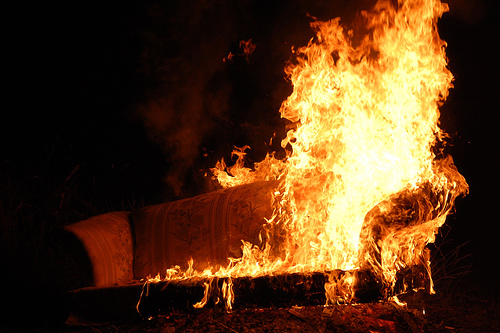Halogenated flame retardants are chemical compounds containing chlorine or bromine in its chemical structure. The most commonly used flame retardants in consumer products such as electronic goods or sofas belong to the group of polybrominated diphenyl ethers (PBDEs).
The value of PBDEs in preventing fires has been questioned due to potential health concerns in humans or wildlife. Of the three forms of PBDEs used in commercial mixtures, penta and octa have already been regulated and phased out of manufacturing in North America and Europe. Currently, alternatives are being investigated to replace the deca form of PBDEs.
At the latest SOCAAR seminar, Dr. Emma Goosey, a postdoctoral research fellow with the Diamond Environmental Group in the Department of Geography at the University of Toronto, discussed the concentrations of PBDE compounds measured from a variety of indoor and outdoor environments across Toronto.
Goosey and her colleagues were particularly interested to understand where these PBDE compounds are found and how far they can migrate from the indoor source environment to the local environment. Goosey explains that PBDE compounds get into the outdoor environment by either volatile compounds off-gassing from the product surface, or microparticles from the wear and tear of products overtime. Although these particles are produced in an indoor environment, they are mobile and can be released into the local environment by air or wastewater. For example particles collected on clothing are subsequently transported into the wastewater system during laundry, and eventually out to Lake Ontario. Consequently the fish population in Lake Ontario can also contain varying concentrations of these PBDE compounds.
According to Goosey, studies have shown a variety of human and ecological health concerns with PBDE compounds. For example, neurodevelopment and behaviour changes in infants and newborns due to the thyroid and reproductive effects from these compounds. Toxic compounds such as carbon monoxide and hydrogen cyanides can also be produced during ignition. Researchers have also found physical and behavioural effects on animals such as birds, fish and other mammals including egg shell thinning and aggression.
Although the production of penta and octa compounds was phased out from Canadian manufacturing in 2008, Goosey found no concentration differences in outdoor air when comparing data from 2006 to 2010. Also, there were no spatial and temporal variability changes for data collected from 2008 to 2011. The highest concentration of PBDE compounds was found in Toronto’s downtown area, which is linked to the area’s high building density.
Goosey said they are now focusing on measuring the concentrations of alternative flame retardants found in indoor and outdoor environments. One challenge is determining the formulations of these alternative flame retardants. Currently, many of the chemical compounds used in commercial alternative flame retardants are unknown, making it difficult to measure the exact concentrations. But Goosey believes the alternative compounds may use formulations that are similar to PBDE, and they can detect for those known chemicals.

